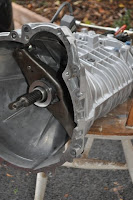Beautiful sunrise this morning.
I spoke to the guys at GBS yesterday about how to install an engine and gearbox on my own. There are two methods. The first is to mate the engine and gearbox and fit both as a single unit. This is difficult on your own but not impossible. The difficulty is the weight of the combined unit and manoeuvring it into the chassis opening whilst it dangles from the crane. The second is to fit them separately: the gearbox first and then the engine. The latter is simpler on your own because the gearbox can be positioned manually and the engine can go in almost vertically on the hoist.
 I decided to fit them separately.
I decided to fit them separately.

 First I needed to remove some gearbox casing from the base and bottom corner, and check that the clutch is aligned properly after fitting the spigot bearing. To do this I fitted the two spacers to the gearbox casing and mated the engine and gearbox, bolting it together so that it can be lifted as a single item. The engine spline slid straight into the gearbox and spigot without problem. With the unit dangling on my crane I marked the areas of the casing that needed to be removed.
After a few minutes with my 9 inch angle grinder, both areas had been removed.
First I needed to remove some gearbox casing from the base and bottom corner, and check that the clutch is aligned properly after fitting the spigot bearing. To do this I fitted the two spacers to the gearbox casing and mated the engine and gearbox, bolting it together so that it can be lifted as a single item. The engine spline slid straight into the gearbox and spigot without problem. With the unit dangling on my crane I marked the areas of the casing that needed to be removed.
After a few minutes with my 9 inch angle grinder, both areas had been removed.
 Next the gearbox mount must first be fitted. It requires a little reshaping first of all, followed by drilling the new mounting holes to 8mm. It is then installed from below - fully tightened and thread-locked.
Next the gearbox mount must first be fitted. It requires a little reshaping first of all, followed by drilling the new mounting holes to 8mm. It is then installed from below - fully tightened and thread-locked.
With the gearbox lifted from underneath with my trolley jack, I eased it into place on the mounting and finger tightened the 3 bolts to the prop shaft.
Now the gearbox is in place (approximately) the engine can be dropped in from above vertically. Having already ensured that the gearbox and engine go together easily, it didn't take long to drop the engine in and mate it with the gearbox once more. Quite straight forward really. Then I found the problem. I didn't have the fixing kit that connects the engine mounts either to the engine or the chassis plates. It was all going so well. As Newark is a 3 hour round trip, I called GBS and they kindly agreed to put the packs in the first class post - maybe tomorrow........
 With the engine in place, the next job is fitting of the side panels before final fit of the front suspension.
With the engine in place, the next job is fitting of the side panels before final fit of the front suspension. To fix the side panels I have elected to only use rivets on the underside of the panel - where they can't be seen. Where the chassis meets the panel I have used "black glue". I am really impressed by this stuff and don't believe the panel will move at all once it is cured. Seen in the photo on the right is the first stage of the process. I will bend and fix the rear portion after freeing the clamps from the front, once it has dried.
To fix the side panels I have elected to only use rivets on the underside of the panel - where they can't be seen. Where the chassis meets the panel I have used "black glue". I am really impressed by this stuff and don't believe the panel will move at all once it is cured. Seen in the photo on the right is the first stage of the process. I will bend and fix the rear portion after freeing the clamps from the front, once it has dried.






























